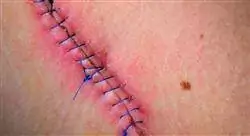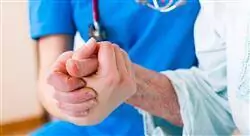University certificate
Scientific endorser

The world's largest faculty of nursing”
Introduction to the Program
With this 100% online Master's Degree, you will master the most sophisticated techniques to provide comprehensive care in the Home Hospitalization environment”

Home hospitalization is the driving force behind the transformation of modern healthcare, focusing on individuals and their healthcare and social needs. The demographic shift requires a radical rethinking of healthcare, which was once centered on acute processes and cure as the primary objective, with hospitals at the center of attention. Now, the focus is on nursing that is primarily dedicated to care, with the person and their immediate environment—the home—at the center. This approach does not compromise the quality of care or the use of intensive hospital resources, but it significantly increases efficiency in the use of both public and private resources.
This university program is designed to delve into all the aspects that make home hospitalization unique and different from other specialties, while also highlighting its weaknesses and future opportunities, taking advantage of new educational technologies. The curriculum is presented rigorously, with the latest scientific evidence and clinical cases that aim to advance our knowledge, sharing experiences and innovative techniques already practiced by professionals and in various home hospitalization units worldwide.
Regarding the methodology of the program, TECH employs its disruptive Relearning method to reinforce knowledge progressively and naturally. The only requirement for nurses is to have an electronic device with internet access (such as a mobile, tablet, or computer) to access the Virtual Campus and enjoy the most comprehensive educational content available in the academic market. Without a doubt, this immersive experience will allow graduates to experience a significant leap in the quality of their professional trajectory.
You will deepen your understanding of managing complex pathologies, including chronic, oncological, and palliative patients who require specialized care”
This Master's Degree in Home Hospitalization for Nursing contains the most complete and up-to-date scientific program on the market. The most important features include:
- The development of practical cases presented by experts in Home Hospitalization for Nursing
- The graphic, schematic, and practical contents with which they are created, provide scientific and practical information on the disciplines that are essential for professional practice
- Practical exercises where the self-assessment process can be carried out to improve learning
- Special emphasis on innovative methodologies in Home Hospitalization for Nursing
- Theoretical lessons, questions to the expert, debate forums on controversial topics, and individual reflection assignments
- Content that is accessible from any fixed or portable device with an Internet connection
Perfect your ability to manage Home Hospitalization with a comprehensive and multidisciplinary approach”
The program includes professionals from the field of Home Hospitalization for Nursing, who bring their real-world experience into this course, alongside recognized specialists from leading societies and prestigious universities.
The multimedia content, developed with the latest educational technology, will provide the professional with situated and contextual learning, i.e., a simulated environment that will provide an immersive learning experience designed to prepare for real-life situations.
This program is designed around Problem-Based Learning, whereby the student must try to solve the different professional practice situations that arise throughout the program. For this purpose, the professional will be assisted by an innovative interactive video system created by renowned and experienced experts.
You will manage new technologies such as Telemedicine and Remote Monitoring, optimizing the follow-up of patients at home”

Take advantage of all the benefits of TECH’s Relearning methodology, which will allow you to organize your time and study pace, adapting to your schedule”
Why study at TECH?
TECH is the world’s largest online university. With an impressive catalog of more than 14,000 university programs available in 11 languages, it is positioned as a leader in employability, with a 99% job placement rate. In addition, it relies on an enormous faculty of more than 6,000 professors of the highest international renown.

Study at the world's largest online university and guarantee your professional success. The future starts at TECH”
The world’s best online university according to FORBES
The prestigious Forbes magazine, specialized in business and finance, has highlighted TECH as “the world's best online university” This is what they have recently stated in an article in their digital edition in which they echo the success story of this institution, “thanks to the academic offer it provides, the selection of its teaching staff, and an innovative learning method aimed at educating the professionals of the future”
A revolutionary study method, a cutting-edge faculty and a practical focus: the key to TECH's success.
The most complete study plans on the university scene
TECH offers the most complete study plans on the university scene, with syllabuses that cover fundamental concepts and, at the same time, the main scientific advances in their specific scientific areas. In addition, these programs are continuously being updated to guarantee students the academic vanguard and the most in-demand professional skills. In this way, the university's qualifications provide its graduates with a significant advantage to propel their careers to success.
TECH offers the most comprehensive and intensive study plans on the current university scene.
A world-class teaching staff
TECH's teaching staff is made up of more than 6,000 professors with the highest international recognition. Professors, researchers and top executives of multinational companies, including Isaiah Covington, performance coach of the Boston Celtics; Magda Romanska, principal investigator at Harvard MetaLAB; Ignacio Wistumba, chairman of the department of translational molecular pathology at MD Anderson Cancer Center; and D.W. Pine, creative director of TIME magazine, among others.
Internationally renowned experts, specialized in different branches of Health, Technology, Communication and Business, form part of the TECH faculty.
A unique learning method
TECH is the first university to use Relearning in all its programs. It is the best online learning methodology, accredited with international teaching quality certifications, provided by prestigious educational agencies. In addition, this disruptive educational model is complemented with the “Case Method”, thereby setting up a unique online teaching strategy. Innovative teaching resources are also implemented, including detailed videos, infographics and interactive summaries.
TECH combines Relearning and the Case Method in all its university programs to guarantee excellent theoretical and practical learning, studying whenever and wherever you want.
The world's largest online university
TECH is the world’s largest online university. We are the largest educational institution, with the best and widest online educational catalog, one hundred percent online and covering the vast majority of areas of knowledge. We offer a large selection of our own degrees and accredited online undergraduate and postgraduate degrees. In total, more than 14,000 university degrees, in eleven different languages, make us the largest educational largest in the world.
TECH has the world's most extensive catalog of academic and official programs, available in more than 11 languages.
Google Premier Partner
The American technology giant has awarded TECH the Google Google Premier Partner badge. This award, which is only available to 3% of the world's companies, highlights the efficient, flexible and tailored experience that this university provides to students. The recognition as a Google Premier Partner not only accredits the maximum rigor, performance and investment in TECH's digital infrastructures, but also places this university as one of the world's leading technology companies.
Google has positioned TECH in the top 3% of the world's most important technology companies by awarding it its Google Premier Partner badge.
The official online university of the NBA
TECH is the official online university of the NBA. Thanks to our agreement with the biggest league in basketball, we offer our students exclusive university programs, as well as a wide variety of educational resources focused on the business of the league and other areas of the sports industry. Each program is made up of a uniquely designed syllabus and features exceptional guest hosts: professionals with a distinguished sports background who will offer their expertise on the most relevant topics.
TECH has been selected by the NBA, the world's top basketball league, as its official online university.
The top-rated university by its students
Students have positioned TECH as the world's top-rated university on the main review websites, with a highest rating of 4.9 out of 5, obtained from more than 1,000 reviews. These results consolidate TECH as the benchmark university institution at an international level, reflecting the excellence and positive impact of its educational model.” reflecting the excellence and positive impact of its educational model.”
TECH is the world’s top-rated university by its students.
Leaders in employability
TECH has managed to become the leading university in employability. 99% of its students obtain jobs in the academic field they have studied, within one year of completing any of the university's programs. A similar number achieve immediate career enhancement. All this thanks to a study methodology that bases its effectiveness on the acquisition of practical skills, which are absolutely necessary for professional development.
99% of TECH graduates find a job within a year of completing their studies.
Master's Degree in Nursing Home Hospitalization
One thing that nurses must keep in mind is that not all healthcare for convalescents takes place in a hospital or clinic. Depending on the severity and type of illness, a patient may be hospitalized at home, both to save unnecessary costs for the healthcare facility and for the comfort of the patient. If one or more nurses are assigned to care for the individual, it is essential that they possess specific knowledge and skills. To address this, TECH Global University offers the Master’s Degree in Home Hospitalization for Nursing, a unique professional program with a comprehensive range of knowledge and a methodological approach based on flexible, immersive distance learning. Consisting of thirteen modules, each with multiple subtopics, this postgraduate degree will update and enhance your skills in areas such as pain management, subsidiary syndromes, palliative care, and more. If you're looking to add a valuable credential to your resume and advance your career, this is your opportunity.
Study a Master’s Degree in Home Hospitalization for Nursing
When a hospital decides to transfer its internal care model to a patient's home, it typically does so in two cases: oncology patients who require palliative care or geriatric patients with chronic diseases, some of whom may also fall into the first category. In our Master’s Degree, we will rigorously train you not only to handle both situations, becoming versatile in topics such as nutrition and drug administration, but we will also teach you fundamental skills such as performing electrocardiograms, ultrasounds, and pulse oximetry at home, as well as applying therapeutic techniques like paracentesis, thoracentesis, oxygen therapy, mechanical ventilation, and more. The enriched multimedia content, along with fully autonomous online classes with no fixed schedules, provided by an excellent faculty, will serve as your guide to boost your career and invest in a better personal and professional future. At TECH, you will find unmatched quality in the market.







